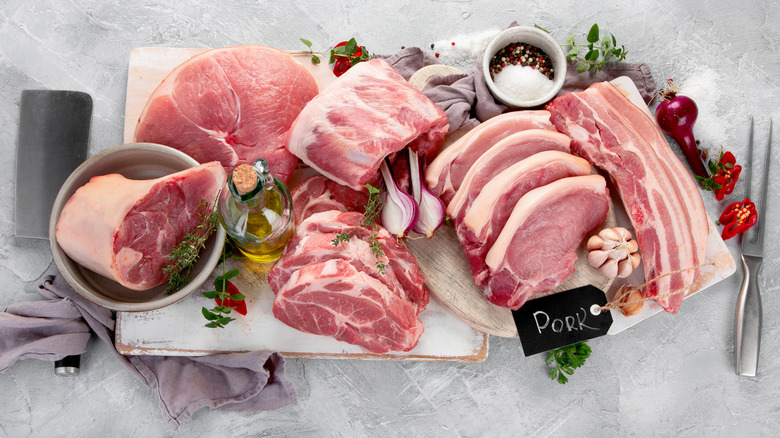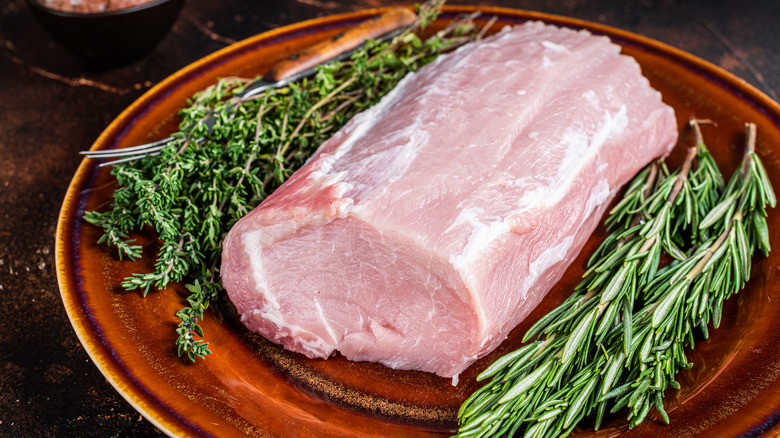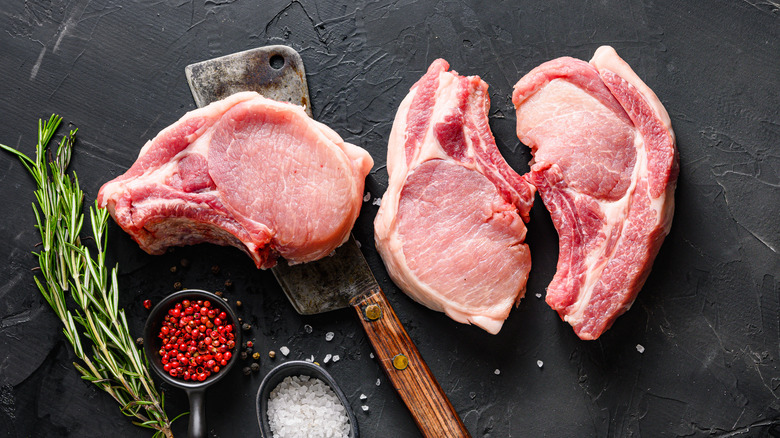Pork Chops Vs. Pork Loin: Is There A Nutritional Difference?
You've probably never given a second thought to where that breakfast bacon, ballpark hot dog, or charcuterie board prosciutto comes from. You know it's from a pig and it tastes good and that's sufficient. But the part of the body of an animal a piece of meat comes from can have a drastic effect on its texture, taste, cost, and nutrition. Fat content and extent of muscle use are usually the two biggest factors at play (per Men's Journal). It's worth knowing a little more about two of the most popular cuts of pork and what they offer up in terms of sustenance.
A pig is first butchered into four sections. Each section is then cut into the smaller, more popular cuts that we are familiar with lining the meat case. Both the pork chop and loin come from the same section (via Your Meat Guide). From a culinary perspective, the two are not interchangeable, so think twice before subbing one in for another in a recipe. It also turns out, they are not cut from the same nutritional cloth either ... but it's a little less straightforward than one may think.
A tale of two loins
Pork loin, not to be confused with pork tenderloin, is the large area that runs from the pig's hip to its shoulders. It is one of the four main areas the animal is first sectioned into when butchered.
The tenderloin is a smaller section of the loin that runs along the backbone and doesn't get much use. Much like with a cow, the tenderloin is lean, having less fat than other parts of the pig. The USDA coins it "extra lean", stating it is comparable to chicken breast. Pork tenderloin earned an American Heart Association checkmark for having less than 5 grams of fat and 2 grams of saturated fat per serving. Due to its leanness, marinades are often needed — which may add extra undesirable nutritional components such as sugar and unhealthy fats (via All Recipes).
Pork loin, on the other hand, has a fat cap that imparts more flavor, per Master Class, and grams. However, the difference is pretty negligible. A 3-ounce serving of pork loin has 5 grams of fat compared to the 3 grams of fat the tenderloin has for the same amount (via The Barbec).
Chop vs. tenderloin
Pork chops are the most popular cut of pork. They are cut from the loin and have different names depending on which area they are cut from. They can be boneless or bone-in. The nutritional content varies depending on which part of the loin the chop is cut from, but the differences are small and involve just fat content.
Given that any variety of pork chop is a part of the loin, the nutritional difference really comes down to comparing the chop cut from the loin versus the pork tenderloin. Head-to-head when matching the same serving size and cooking method, there are some differences thanks to that fat cap.
Comparing a classic pork loin chop to the tenderloin per a standard raw 4-ounce serving, the pork chop has 190 calories and the tenderloin has 150. The chop has 10 grams of fat compared to the tenderloin's 4 grams. The tenderloin only has 1.5 grams of saturated fat while the chop has 3.5. Cholesterol-wise they're very close, with chops having 80 milligrams and the tenderloin having 75. Same with protein — pork chops have 22 grams and the tenderloin has 23 grams per those 4 ounces, making them both an excellent lean source of the macronutrient. Pork tenderloin has a smidgen more iron at 6% of the daily value whereas pork chops have 4% (via Brookview Farm Meats).
Per pork.org, pork as a whole is a good source of vitamins and minerals such as niacin, riboflavin, thiamin, vitamin B6 and B12, and zinc, amongst others. What it really comes down to is your preference regarding fat.


